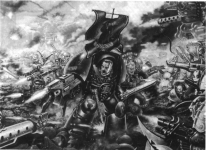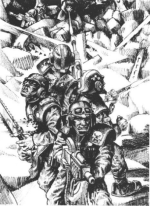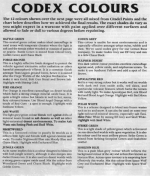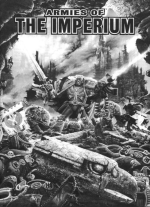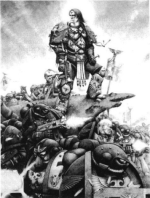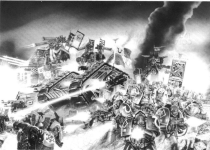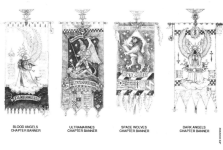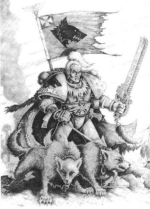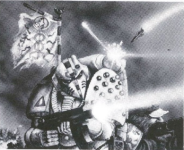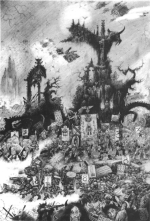SPECIAL SPACE MARINE COMMAND UNITS
Purge Psyker.
The Librarian can use this power to destroy an enemy psyker within 50cm. Purge Psyker can be used to attack an Eldar Warlock, Ork Weirdboy, another Librarian, or other living psyker but not a daemon, Chaos Android, Eldar Wraithguard or Eldar Dreadnought. Basically, Purge Psyker will affect anything not affected by Destroy Daemon and vice versa. Choose a visible target within 50cm and roll 2D6 to represent the strength of the Librarian’s psychic power. The enemy psyker rolls 1D6. If the Librarian's score is higher the enemy psyker is destroyed. If the enemy's score is higher there is no effect unless the score is twice that of the Librarian in which case the Librarian is destroyed by psychic feedback. If the scores are equal both players roll again.
Mind Blast.
The Librarian projects a blast of psychic energy which shreds the mind of living creatures. Choose a target within 25cm and roll a D6. On the roll of a 4, 5 or 6 the target is hit. No armour saving roll is allowed against a Mind Blast. A Mind Blast can be directed against a vehicle with a live crew and has the same effect as a normal hit - it is assumed the crew are slain and the vehicle wrecked. The Mind Blast can also be used against a Titan’s crew, in which case a D6 roll of 4 or more is required to penetrate any shields. If its shields are penetrated the Titan automatically sustains a hit to the head, representing damage to the crew. Work out damage to the head by rolling on the damage chart as normal. A Mind Blast has no effect on Robots as they obviously have no mind, nor on daemons or any daemon-like troops which are not flesh and blood living creatures. A list of the latter is given in the Destroy Daemon attack (below).
Destroy Daemon.
The Librarian unleashes a potent bolt of energy which focuses onto the nearest daemon. The bolt has a maximum range of 25cm and automatically strikes the nearest visible daemon stand or greater daemon. Destroy Daemon works against Eldar Avatars, as well as Wraithguard and Eldar Dreadnoughts, both of which contain the spirit of a dead Eldar. Destroy Daemon is also effective against Chaos Androids which contain a bound daemon. The Librarian player rolls 2D6 to represent his psychic power. The target piece rolls 1D6 if it is a daemon stand or Chaos Android, 2D6 for Wraithguard or Eldar Dreadnought, and 3D6 if it is a Greater Daemon or Avatar. If the Librarian's score is higher the daemon is destroyed. If the daemon’s score is higher then there is no effect unless the daemon’s score is twice that of the Librarian in which case the Librarian is destroyed by psychic feedback. If both scores are equal then the players roll again.
GREY KNIGHTS
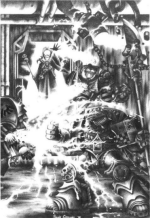
The Grey Knights are the most extraordinary Space Marine Chapter of all. Their secret headquarters is believed to be situated on an outer planet of the solar system, possibly Titan, but only the Inquisition knows its whereabouts for certain. The Grey Knights are daemonhunters, recruited because of their latent psychic talents or extreme psychic resistance, and their role is to provide the Inquisition with a potent fighting arm anywhere in the galaxy. The very existence of daemons and the Chaos Powers is not widely acknowledged outside the Inquisition, as to do so could cause universal fear and terror that would serve the purposes of Chaos only too well. Combat troops are generally kept away from daemonic forces, as few men who encounter these horrors face-to-face survive with their sanity intact. Ordinary Space Marines are too valuable to expose to such horror, although for those unfortunate enough to do so there is the prospect of selective memory removing surgery to ease the pain. Grey Knights are made of tougher stuff, men whose natural resistance protects them from daemonic presence or whose own psychic powers enable them to fight back.
Grey Knights are only deployed against daemonic forces as they are too valuable to risk against conventional enemy. Grey Knights may therefore only be used if you are fighting against a Chaos army. Note that the Grey Knight card is available as a Space Marine and an Imperial Guard support unit. This is indicated on the card by the Space Marine eagle symbol and the Imperial Guard skull. Grey Knights wear steel or brass-coloured Terminator armour and carry a variety of close combat and distance weapons including psychic weapons such as force swords and the nemesis weapon. The Grey Knights have a fleet of fast warp ships and the best astro-navigators that the Inquisition can supply. When they arrive at the battle zone they use teleporters to transport down onto the surface or into the heart of enemy spacecraft.
A Grey Knight stand consists of five Terminator models, and four stands make up a detachment. A Grey Knight detachment may be deployed as normal at the start of the battle or it can be teleported down during any subsequent movement phase. To teleport the detachment nominate a landing point and roll the scatter dice. If the dice shows the teleporter is on target place one stand on the nominated point and the remaining three stands within 6cm of it. If the scatter dice indicates a scatter move the landing point 2D6cm in the direction shown and position the first stand in the place indicated, then place the remaining three stands within 6cm as before. Grey Knights are not affected by the normal morale roll taken when daemons attack, though they are affected by other morale rolls as normal. Grey Knights do not suffer any to hit penalties for shooting at daemons or close combat penalties for fighting against them. If attacked by a psychic power, such as an Eldar Warlock’s psychic attack, a Weirdboy psychic bolt, or a spell from a Greater Daemon, then a Grey Knight stand has a psychic saving throw to represent its psychic resilience. Roll a D6, and on the score of a 4, 5 or 6 the stand is unaffected.
Grey Knights wear Terminator armour which is incredibly thick as well as affording a reasonable degree of mobility. This combines the two advantages of infantry and vehicles, and makes Terminators relatively difficult targets. At long range they are quite small and easily concealed behind localised cover or folds in the ground, while at short range their thick armour protects them from all but the more powerful weapons. To represent this Terminators have an armour saving throw of 6 on a D6 — almost all other infantry stands have no saving throw. Furthermore, because part of their save represents their small size and ability to move quickly, the save never drops below 6 - even if hit by a Volcano Cannon, Tempest Laser or other powerful weapon.
Purge Psyker.
The Librarian can use this power to destroy an enemy psyker within 50cm. Purge Psyker can be used to attack an Eldar Warlock, Ork Weirdboy, another Librarian, or other living psyker but not a daemon, Chaos Android, Eldar Wraithguard or Eldar Dreadnought. Basically, Purge Psyker will affect anything not affected by Destroy Daemon and vice versa. Choose a visible target within 50cm and roll 2D6 to represent the strength of the Librarian’s psychic power. The enemy psyker rolls 1D6. If the Librarian's score is higher the enemy psyker is destroyed. If the enemy's score is higher there is no effect unless the score is twice that of the Librarian in which case the Librarian is destroyed by psychic feedback. If the scores are equal both players roll again.
Mind Blast.
The Librarian projects a blast of psychic energy which shreds the mind of living creatures. Choose a target within 25cm and roll a D6. On the roll of a 4, 5 or 6 the target is hit. No armour saving roll is allowed against a Mind Blast. A Mind Blast can be directed against a vehicle with a live crew and has the same effect as a normal hit - it is assumed the crew are slain and the vehicle wrecked. The Mind Blast can also be used against a Titan’s crew, in which case a D6 roll of 4 or more is required to penetrate any shields. If its shields are penetrated the Titan automatically sustains a hit to the head, representing damage to the crew. Work out damage to the head by rolling on the damage chart as normal. A Mind Blast has no effect on Robots as they obviously have no mind, nor on daemons or any daemon-like troops which are not flesh and blood living creatures. A list of the latter is given in the Destroy Daemon attack (below).
Destroy Daemon.
The Librarian unleashes a potent bolt of energy which focuses onto the nearest daemon. The bolt has a maximum range of 25cm and automatically strikes the nearest visible daemon stand or greater daemon. Destroy Daemon works against Eldar Avatars, as well as Wraithguard and Eldar Dreadnoughts, both of which contain the spirit of a dead Eldar. Destroy Daemon is also effective against Chaos Androids which contain a bound daemon. The Librarian player rolls 2D6 to represent his psychic power. The target piece rolls 1D6 if it is a daemon stand or Chaos Android, 2D6 for Wraithguard or Eldar Dreadnought, and 3D6 if it is a Greater Daemon or Avatar. If the Librarian's score is higher the daemon is destroyed. If the daemon’s score is higher then there is no effect unless the daemon’s score is twice that of the Librarian in which case the Librarian is destroyed by psychic feedback. If both scores are equal then the players roll again.
GREY KNIGHTS

The Grey Knights are the most extraordinary Space Marine Chapter of all. Their secret headquarters is believed to be situated on an outer planet of the solar system, possibly Titan, but only the Inquisition knows its whereabouts for certain. The Grey Knights are daemonhunters, recruited because of their latent psychic talents or extreme psychic resistance, and their role is to provide the Inquisition with a potent fighting arm anywhere in the galaxy. The very existence of daemons and the Chaos Powers is not widely acknowledged outside the Inquisition, as to do so could cause universal fear and terror that would serve the purposes of Chaos only too well. Combat troops are generally kept away from daemonic forces, as few men who encounter these horrors face-to-face survive with their sanity intact. Ordinary Space Marines are too valuable to expose to such horror, although for those unfortunate enough to do so there is the prospect of selective memory removing surgery to ease the pain. Grey Knights are made of tougher stuff, men whose natural resistance protects them from daemonic presence or whose own psychic powers enable them to fight back.
Grey Knights are only deployed against daemonic forces as they are too valuable to risk against conventional enemy. Grey Knights may therefore only be used if you are fighting against a Chaos army. Note that the Grey Knight card is available as a Space Marine and an Imperial Guard support unit. This is indicated on the card by the Space Marine eagle symbol and the Imperial Guard skull. Grey Knights wear steel or brass-coloured Terminator armour and carry a variety of close combat and distance weapons including psychic weapons such as force swords and the nemesis weapon. The Grey Knights have a fleet of fast warp ships and the best astro-navigators that the Inquisition can supply. When they arrive at the battle zone they use teleporters to transport down onto the surface or into the heart of enemy spacecraft.
A Grey Knight stand consists of five Terminator models, and four stands make up a detachment. A Grey Knight detachment may be deployed as normal at the start of the battle or it can be teleported down during any subsequent movement phase. To teleport the detachment nominate a landing point and roll the scatter dice. If the dice shows the teleporter is on target place one stand on the nominated point and the remaining three stands within 6cm of it. If the scatter dice indicates a scatter move the landing point 2D6cm in the direction shown and position the first stand in the place indicated, then place the remaining three stands within 6cm as before. Grey Knights are not affected by the normal morale roll taken when daemons attack, though they are affected by other morale rolls as normal. Grey Knights do not suffer any to hit penalties for shooting at daemons or close combat penalties for fighting against them. If attacked by a psychic power, such as an Eldar Warlock’s psychic attack, a Weirdboy psychic bolt, or a spell from a Greater Daemon, then a Grey Knight stand has a psychic saving throw to represent its psychic resilience. Roll a D6, and on the score of a 4, 5 or 6 the stand is unaffected.
Grey Knights wear Terminator armour which is incredibly thick as well as affording a reasonable degree of mobility. This combines the two advantages of infantry and vehicles, and makes Terminators relatively difficult targets. At long range they are quite small and easily concealed behind localised cover or folds in the ground, while at short range their thick armour protects them from all but the more powerful weapons. To represent this Terminators have an armour saving throw of 6 on a D6 — almost all other infantry stands have no saving throw. Furthermore, because part of their save represents their small size and ability to move quickly, the save never drops below 6 - even if hit by a Volcano Cannon, Tempest Laser or other powerful weapon.



